Read Reviews
The Best Outdoor Security Lights
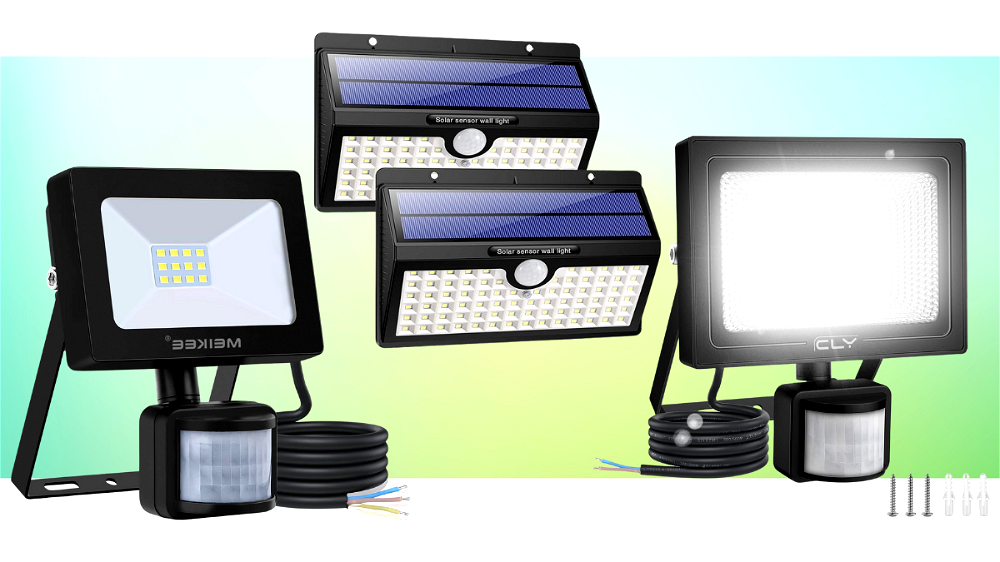
-
HETP Solar Motion Sensor Security Lights
-
CLY LED Floodlight Security Light
-
MEIKEE LED Floodlight
-
HETP Solar Lights
Outdoor Security Light Reviews
- Powerful and bright: light covers a good distance so suitable for larger gardens
- Very easy to install with just two screws needed for each light (included)
- Solar charge lasts for a whole night (depending on chosen setting) provided lights are installed in a sunny location
- Good detection range of approximately 6 metres
- Instructions are not very clear and can be quite small and difficult to read
- When there is less sunlight, over the winter months, the lights do not hold as much charge
For bright outdoor security lights that are both cheap to run and inexpensive to buy, these HEPT Solar Motion Sensor Security Lights are a great option to consider.
They have an IP65 waterproof rating, making them suitable for outdoor use, don’t use any mains power and detect movement up 6 metres away.
There are also two lights included which makes these some of the best outdoor security lights in terms of value for money. Both lights can be rigged up in the same spot, or used across your property to deter intruders from different areas.
With large solar panels located on top, these motion-sensor lights charge up automatically during the day making them exceptionally energy efficient. The one drawback of this is that they can’t be used in a covered area, like a porch, as the solar panel needs to charge. Nevertheless, in spaces where they receive enough sunlight, they are very effective.
Each light has a choice of three settings, so that can be adjusted individually depending on your preference. On setting one, the light automatically turns on, to full brightness, when it gets dark. On setting two, the light is always dimly illuminated, and comes on to full brightness the motion sensor detects movement. On setting three, the lights turn on to full brightness after sensing movement, and then turn off again. On full brightness, the lights produce 1400 lumens.
Four screws are provided, to help with fixing the lights in place and they offer easy DIY installation with no wires to worry about.
Although instructions are included, there is a small amount of trial and error involved with understanding the different modes (the written manual is not overly clear). Nevertheless, the set-up is sill relatively intuitive and it doesn’t take long to get these outdoor security lights up and running.
Did you find this review helpful?
- Very bright especially given the small size
- Compact build that looks neat and unobtrusive installed in your driveway or garden
- Mains powered unit so can be positioned in any location without relying on the sun to charge it
- Possible to choose how long the light stays on for making functions of the light more versatile
- Only 1 m of cable supplied which is a little short in some contexts
- In very exposed areas it may not stay completely protected against heavy rain
- No three-pin plug fitted, comes as bare cable
Unlike many models, this CLY LED Floodlight Security Light will let you choose exactly how long you want your outdoor security light to stay on for when the motion sensor detects movement.
This is useful for several reasons. For example, if you have the security light positioned near a door, you may benefit from more a longer light in order to find your keys and get them in the lock, in which case the 600 second or 120 second light, after the initial motion detection, will be useful.
Alternatively, if you want the light to be on for a shorter period of time, to spook potential intruders whilst remaining energy efficient, the 45 second and 10 second option will be ideal.
The security light is fitted with LED lights and uses 20 W of mains power. It comes with one metre of cable included. There’s no plug fitted, so the light can either be wired in, or connected to a three-pin plug – it comes with revealed wires as shown in the photo so a qualified electrician is needed for installation.
Suitable for outdoor use, this security light has a waterproof rating of IP66. Its motion detection works up to approximately 12 metres away, and when the motion sensor is triggered the light produces a bright, white light that covers a distance of several metres.
There are two light settings to choose between; either the light senses motion during both day and night, or it only comes on when motion is sensed at night. Naturally, the second option will be more useful and save energy.
Overall, this is one of the best outdoor security lights in terms of versatility. With a range of lighting periods available, the light can be used for different functions depending on where it is placed. Running on mains power, it also doesn’t matter if the light is positioned in the shade.
Did you find this review helpful?
- Very sturdy build that’s easy to install
- Length of light duration can be adjusted as desired
- Easily lights up small-medium size gardens up to 50ft
- Cable is longer than others on the market at 1.5m, which makes installing this light a little easier
- Small unit that looks neat and unobtrusive installed in driveways or gardens
- No three-pin plug fitted, comes as bare cable
- Waterproofing isn’t the best - some users recommend installing in a sheltered area
Buying security lights on a budget can result in poor performance, but this MEIKEE LED Floodlight is bright, effective and reliable, even though it has an inexpensive price tag. As a result, it’s the best outdoor security light to buy on a budget.
This 15 W outdoor security light is fitted with bright LED lights and sensitive motion detection. It is sufficiently powerful to light up a driveway and the motion sensor works over roughly that same distance too. It has a motion detection range of approximately 11 m.
Given that the unit itself is relatively small, measuring approximately 15 x 12 x 6 cm, it’s a compact and discreet size – suitable for positioning on sheds, garages and walls.
It has a waterproof rating of IP66, so this outdoor flood light suitable for capable of standing up to most UK weather. It seems to fare relatively well even in more extreme weather like snow. However, there have been some user reports of condensation getting under the glass after heavy rain.
This outdoor security light has two power settings which come in handy depending on where the light will be used. On one of the settings, the outdoor flood light will only illuminate if the motion sensor detects movement at night time, whilst the other setting will work both during the day and night (useful if positioned in a dim outdoor area or warehouse).
These settings can be changed by using a switch on the base of the motion sensor light. There is a second switch for adjusting the duration that the light stays on for. It can be adjusted to 10, 45, 120 or 600 seconds.
As is quite common with security lights, no three-pin plug is provided and therefore a professional will be required to connect this outdoor flood light to mains electricity. This will likely be the most time-consuming part of installing this outdoor motion sensor light, as fitting it to the wall is quite straight forward.
The mains cable measures 1.5 m, which is quite generous compared to other models, and another reason why this is one of the best outdoor security lights to buy on a budget.
Did you find this review helpful?
- Extremely bright especially given the small size
- Comes with mounting hardware included and installation is very easy
- Solar powered so there’s no cable or wiring required
- Three lighting modes to choose from depending on your security needs
- Motion detection cannot be adjusted and some households may find passers by or cars trigger the light
- Don’t charge particularly well in the winter months when it’s overcast
These four-sided HETP Solar Lights are well designed for better illuminating corners of the garden. Instead of only lighting the area under or in front of the light, these outdoor security lights shine at four angles, giving 270° of illumination.
Two motion sensor security lights come included, and they run on solar power so can be placed in areas that don’t have access to a power source. Of course, being solar powered, they do need to positioned somewhere that gets enough sunlight and can’t be fixed anywhere too shaded.
Each unit has 180 LED lights and gives off a very bright light. The spread of light is more extensive than standard security lights, and the motion sensors detect at a distance of approximately 3 – 5 metres.
With an IP65 waterproof rating, these lights are suitable for use outdoors, and they are easy to install.
There are three settings to change between – the same as the other HETP solar light featured on this page. The light can either: be set to come on permanently once it gets dark – lasting for up to eight hours if fully charged; be on dimly all the time, and get bright when motion is detected; or, be off until motion is detected, at which point the bright light will illuminate.
Due to its design, this is one of the best outdoor security lights to light up more angles of the garden. Also, as a solar-powered option, it can be placed in areas that don’t have access to mains power.
Did you find this review helpful?
How to Choose the Best Outdoor Security Light
Outdoor security lights can have several uses. Primarily, they deter intruders who might be on your property. Even in the dead of night, if a bright light comes on, anyone snooping around your property is likely going to feel spooked and ‘seen’. They work well on their own, or can also be effectively paired with security cameras.
In addition to this, motion-sensor security lights can be useful lighting in outdoor spaces in general. This is perfect for returning home at night or taking the dog out for a late-night toilet trip.
There are a lot of different options on the market, and the information below has been put together to help you choose the best security light for your garden.
READ NEXT: Do Outdoor Security Lights Deter Burglars?
Brightness
Brightness is measured in lumens. Bright security lights should have around 2000 lumens to make an impact. This is especially true if you want to be able to notice when the motion activated light turns on from inside your home.
Given that security lights are so bright, often acting as flood lights in the garden, it’s important not to position them anywhere where they could dazzle or confuse passing motorists.
Look out for security lighting that’s equipped with a few different settings because this will give you more control over both the brightness and energy consumption. Some outdoor lights will remain off until they sense movement, whilst others have the option to be partially on all the time and then become brighter when the motion detector is triggered.
The most important thing, when it comes to the brightness of outdoor lighting, is making sure that the light is successful bright enough to fulfil its function. Check how much distance the bright flood light will cover: If a light has a sensor range of approximately 5 – 10 m, and can project equally as far, this will be suitable for most outdoor spaces.
READ NEXT: Ways to Make Your Garden More Secure
Waterproofing
With the ever-unpredictable UK weather, it’s essential that your outdoor light is both waterproof and weatherproof. Waterproofing is indicated by an ‘IP’ rating, so it’s worth understanding what these mean in more detail.
IP stands for ‘ingress protection’, and if an electrical product has been tested and given an IP rating, this rating will be written as ‘IP’ followed by two numbers. For example, IP56.
The first number refers to ‘solids’ and describes how well protected the machine is from the ingress of solid objects like fingers (IP1) or dust (IP5/6). The higher the number, the more protected the item is against an ingress of solids. The scale only goes up to 6.
READ NEXT: Spiky Plants, Hedges & Bushes (For Added Home Security)
The second number refers to ‘fresh water’ and describes how well protected the machine is from different applications of water. For example, if the second number is ‘1’, then the item is protected against vertically falling drops of water, like condensation. If the second number is ‘4’, it’s protected from water being splashed from all directions. And, if it’s ‘6’, it’s protected from strong jets of water. This scale goes up to 8.
Some products may have an ‘X’ instead of a number in one of the two positions. This means that the product hasn’t been tested specifically for that type of ingress. For example a machine with IPX6 has been tested as being protected from strong jets of water, but its protection against solid ingress is unknown.
Outdoor security lighting should have at least a ‘5’ in each column.
READ NEXT: Things Burglars Looks For (And How to Avoid Them)
Installation
Outdoor security lights are usually wall mounted; they are best placed approximately 1.8 – 3 metres above the ground, angled downwards. Outdoor lights that are higher up will produce a wider radius of light.
The best outdoor security lighting for easy installation will be solar powered. With solar lights there are no wires to think about and, as long as the solar panel gets enough light, you can get the outdoor light up and running on the day you receive it.
Most mains-powered security lights will require an electrician to fit them. Be warned – they don’t often come with a plug fitted.
READ NEXT: Things You Can Legally Put on Your Fence to Stop Burglars
Positioning Your Security Light
Naturally, you’ll want your security light positioned in the area where you sense it will be most useful to deter intruders; however, there are a few other things to consider as well.
Security lighting is often complained about, so ensure you position your lighting so that it won’t disturb neighbours or shine into their home.
Garden lights also need to be positioned somewhere where they will be able to detect movement. Ideally, you want them positioned in areas of your garden that would most likely be crossed by intruders if they were to enter your garden. Pay attention to the motion detection range on your new security lighting and how far its can detect motion from. This will impact where it should be placed.
Also, remember that if you stop noticing the light going on (for instance, if your pet regularly activates the motion detector and you eventually stop reacting), then the outdoor lighting is no longer working as a security measure.
Ensure your light isn’t activated by cars passing on the road outside your home as this can distract drivers and cause accidents.
READ NEXT: The UK’s Latest Burglary Statistics
Outdoor Security Light FAQs
Motion sensor lights are designed to alert to potential danger or deter intruders. As a result, these lights are more like flood lights, and they need to be a lot brighter than your other outdoor lights.
The brightness you require for outdoor security lighting will depend on the size of the space you want to illuminate. The best outdoor security lights for most patios and driveways will have between 800 and 2000 lumens.
If you’ve got a large garden to illuminate or a very large driveway, you may want up to 3000 lumens for your outdoor lighting.
It’s also important to choose the right location for your motion sensor lights, as this will also influence how secure they are. Ensure when the light is switched on there are no dark shadows, as these can be used for hiding in.
Finally, ensure that any super bright security light isn’t going to disturb your neighbours. If it’s going to shine into their bedroom or living room, it’ll need to be adjusted.
Colour temperature is measured in kelvins. The higher the kelvin, the cooler the colour temperature is. Lighting with 2700K to 2800K provides a warm glow with very few blue tones.
As you reach up to 4500K or higher, the colour becomes a lot cooler. These lights contain a subtle hint of blue and are very white looking.
For motion sensor lights, you’ll likely want a colour temperature between 5500K and 6000K. These will cover the area in a bright, white light that can help deter unwelcome visitors.
Outdoor motion sensor lights should be placed around 1.8 – 3 metres above the ground, facing downwards. This will ensure the sensor range reaches a good distance, that the motion detector will be easily activated, and that the flood lights cover a good area.
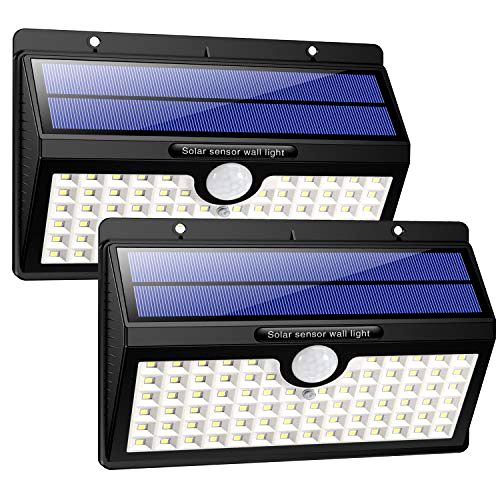
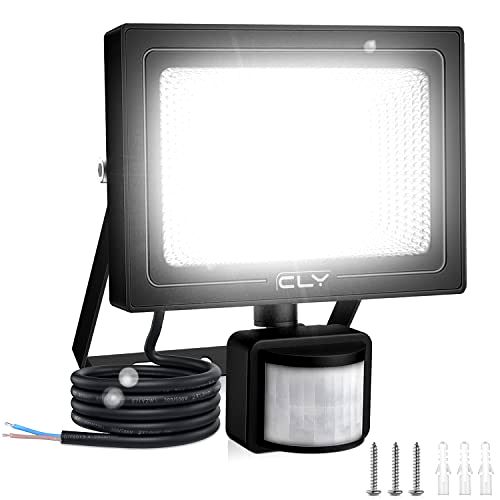
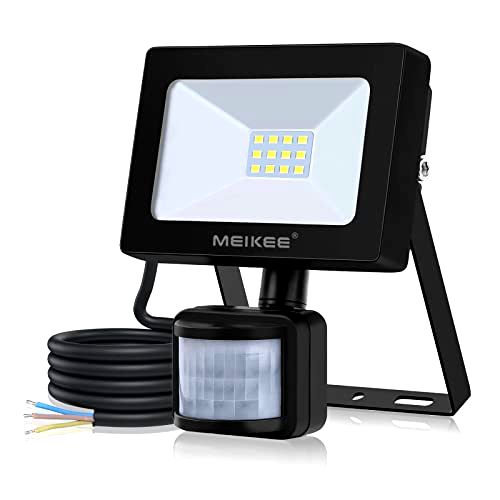
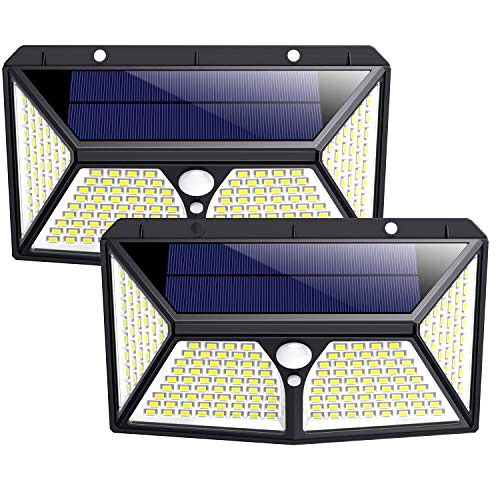

Share